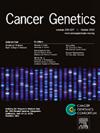Rab5if is a potential therapeutic target of NSCLC
IF 2.1
4区 医学
Q4 GENETICS & HEREDITY
引用次数: 0
Abstract
Purpose
Due to disease progression and drug resistance, non-small cell lung cancer(NSCLC) mortality remains high, and the study of new targets that can inhibit tumor growth is very necessary. The purpose of this study was to investigate the role of Rab5if in the occurrence and development of NSCLC and explore its potential role in the treatment of NSCLC.
Materials and Methods
Rab5if overexpression and knockdown non-small cell lung cancer cell lines were constructed by lentivirus. Cellular assays were conducted to assess the impact of Rab5if on the functionality of lung cancer cells, The mechanism by which Rab5if influences the function of lung cancer cells was confirmed through Western blot analysis. The in vivo experiment was used to further verify the results of the in vitro experiment.
Results
Bioinformatics research found Rab5if mRNA increased in patients with NSCLC. Increased mRNA and protein levels of Rab5if were confirmed in local human NSCLC tissues. Knockdown of Rab5if in NSCLC cell lines by lentivirus significantly inhibited cell vigour, propagation and migration. In addition, mitochondrial function was impaired in lung cancer cells after Rab5if knockdown. In contrast, Rab5if overexpression promoted the proliferation and migration of NSCLC. Moreover, the impact Rab5if on the function of lung cancer cells was realized through the AKT-mTOR pathway. In the in vivo study, growth inhibition were observed in lung cancer xenografts transfected with Rab5if shRNA in nude mice. Similarly, xenografts of nude mice overexpressing Rab5if grew rapidly. The same pathway as in vitro was confirmed in vivo.
Conclusion
Rab5if is expected to be a novel therapeutic target for NSCLC.
Rab5if是NSCLC的潜在治疗靶点
目的非小细胞肺癌(non-small cell lung cancer, NSCLC)由于疾病进展和耐药,死亡率居高不下,研究抑制肿瘤生长的新靶点是非常有必要的。本研究旨在探讨Rab5if在非小细胞肺癌发生发展中的作用,并探讨其在非小细胞肺癌治疗中的潜在作用。材料与方法利用慢病毒构建rab5if过表达、低表达非小细胞肺癌细胞系。通过细胞实验评估Rab5if对肺癌细胞功能的影响,通过Western blot分析证实Rab5if影响肺癌细胞功能的机制。采用体内实验进一步验证体外实验结果。结果生物信息学研究发现,Rab5if mRNA在NSCLC患者中表达升高。Rab5if mRNA和蛋白水平在人局部NSCLC组织中升高。慢病毒敲低Rab5if可显著抑制NSCLC细胞株的活力、增殖和迁移。此外,Rab5if敲低后,肺癌细胞线粒体功能受损。Rab5if过表达可促进NSCLC的增殖和迁移。Rab5if对肺癌细胞功能的影响是通过AKT-mTOR途径实现的。在体内研究中,转染Rab5if shRNA的裸鼠肺癌异种移植物生长受到抑制。同样,过表达Rab5if的裸鼠异种移植物生长迅速。在体内证实了与体外相同的途径。结论rab5if有望成为治疗非小细胞肺癌的新靶点。
本文章由计算机程序翻译,如有差异,请以英文原文为准。
求助全文
约1分钟内获得全文
求助全文
来源期刊

Cancer Genetics
ONCOLOGY-GENETICS & HEREDITY
CiteScore
3.20
自引率
5.30%
发文量
167
审稿时长
27 days
期刊介绍:
The aim of Cancer Genetics is to publish high quality scientific papers on the cellular, genetic and molecular aspects of cancer, including cancer predisposition and clinical diagnostic applications. Specific areas of interest include descriptions of new chromosomal, molecular or epigenetic alterations in benign and malignant diseases; novel laboratory approaches for identification and characterization of chromosomal rearrangements or genomic alterations in cancer cells; correlation of genetic changes with pathology and clinical presentation; and the molecular genetics of cancer predisposition. To reach a basic science and clinical multidisciplinary audience, we welcome original full-length articles, reviews, meeting summaries, brief reports, and letters to the editor.
 求助内容:
求助内容: 应助结果提醒方式:
应助结果提醒方式:


